Circadian Rhythm and Chronotypes
There has always been a debate if those two types of people really exist. I’m speaking of the owl and the lark. The “owl” tends to be the real “Batman” or so to speak “Owlman”, staying up late and feeling comfortable and productive during the night, beating up bad guys in the streets of Gotham City – or wherever “Owlman” would live…
The lark however tends to be the so called “early bird” and lives according to the motto: “The early bird catches the worm”.
But let’s discuss if those two chronotypes really exist or whether it’s just a subjective point of view thing. Like i.e. New York Times Best Selling Author Tim Ferriss, who claims to be especially productive after midnight.
A good read by Ferriss by the way is his book “Tools of Titans” [Affiliate Link], where you can find me on page 80.
The term “chrono/type” derives from Greek: chronos = time and Greek: typtein/Typus = to beat (Becher et al. 1995). It (the term) is used in the study of circadian typo/logy. The suffix -logy again is Greek: logos = speaking, word, talk (Becher et al. 1995).
The Merriam Webster Dictionary describes chronotype as:
“the internal circadian rhythm or body clock of an individual that influences the cycle of sleep and activity in a 24-hour period.” (Merriam Webster, 2019).
Kivelä et. al. further describe chronotype and its functions as:
“Circadian rhythmicity in humans is apparent in a wide range of biological and behavioral functions, from hormone secretion and body temperature to sleep-wake patterns and socialization. These endogenous diurnal variations are determined by time “chrono,” and controlled by our internal circadian clocks and external environmental cues “zeitgebers,” such as light” (Kivelä et al., 2018).
There might be a third Chronotype or how I call it, the “Pigeon-Type”
Following the analogy of the owl and the lark, there seems to be another chronotype – or “bird” -, the so called “intermediate type” which tends to be a reflection of the vast majority (60%) of people (Adan et al., 2012).
Now it would be interesting to find a bird that resembles those sleep patterns. If you find something appropriate, please let me know J
For so long I’d like to call the intermediate type, the “pigeon type” (Ó 2019, B.Stößlein), as pigeons might be one of the most common birds.
According to the bird-chronotype analogy there seem to be three types of people:
1. The morning type (the lark)

Likes to go to bed rather early and therefore wakes up in the wee hours of the morning. According to that those people achieve the peak of their mental and physical performance mostly in the early part of the day.
2. The intermediate type (the pigeon)
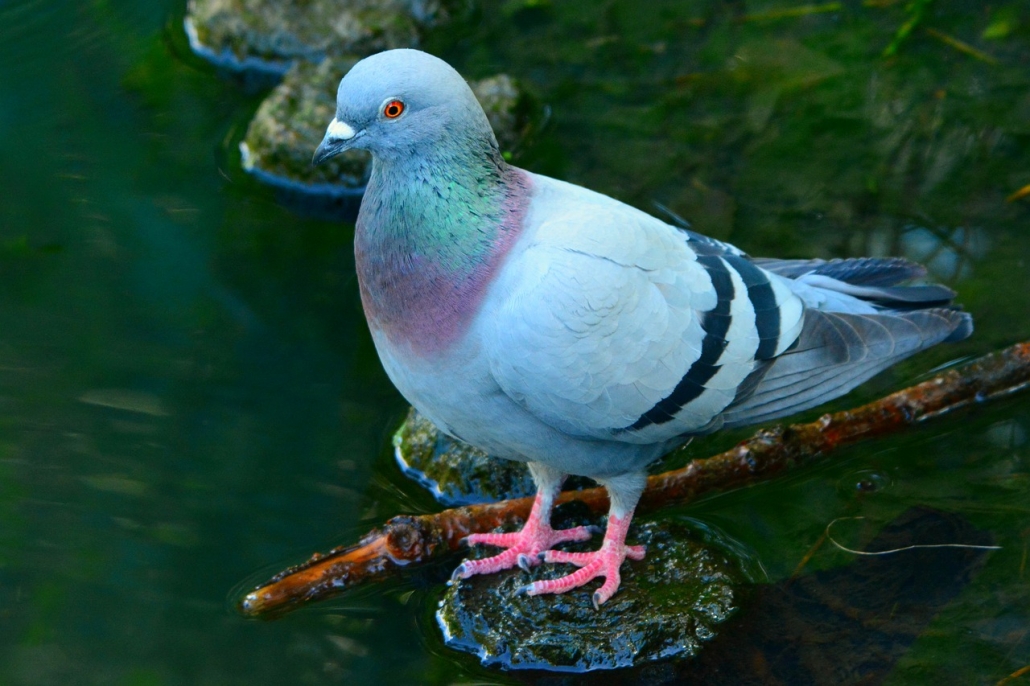
As described above this individual lies between the morning and the evening type.
The “pigeon type” resembles 60% of the population and therefore seems to be the most common chronotype. That’s why I call it the “pigeon type”. It’s everywhere…and please don’t give me this shi** that pigeons are flying rats. Nothing can be further from the truth!
3.The evening type (the owl)
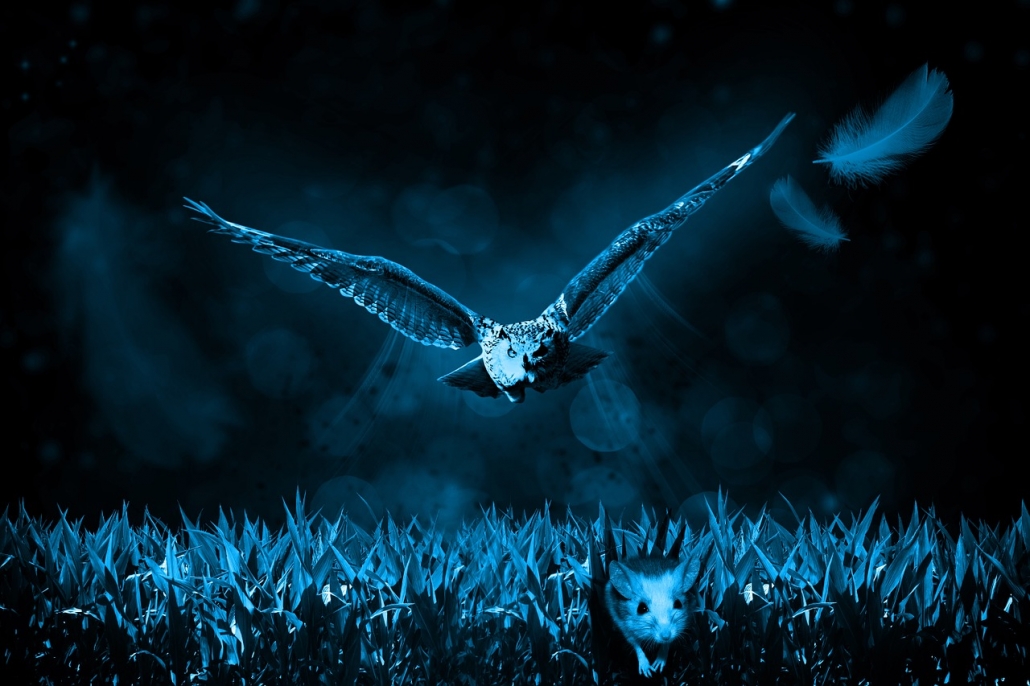
The evening type is simply the opposite of it’s morning counterpart. What indicates the evening type is: achieving peak in the end of the day, staying up late and therefore waking up rather late the next morning.
Now the question arises in which “bird category” you fall and if you’re born as a special “bird” or if you’re able to “shapeshift” throughout your life, adapting to life’s circumstances i.e. work.
Traditionally questionnaires , like the so called “Morningness-Eveningness Questionnaire” (Horne and Östberg, 1976) and the “Munich Chronotype Questionnaire” (Roenneberg et al., 2003) are commonly used to determine which chronotype you are.
The importance of the Circadian Rhythm
A well timed circadian rhythm (CR) is mandatory due to several reasons, i.e. “ […] the circadian preference can influence physical and mental health, in terms of well-being, but also sickness and disease (Basnet et al., 2017).
Furthermore the increased prevalence of evening types among patients with mood disorders, substance abuse, and sleep disturbances seems to have been proven (Fabian et al., 2016; Au and Reece, 2017; Melo et al., 2017).
The importance doesn’t stop there, though. The CR also seems to have an effect on the activity of the brain, the body’s core temperature, how well the heart and respiratory system work, coagulation and on the immune system (Chan et al., 2012).
Chan et al. moreover state, that the CR seems to influence i.e. also the following:
- mitochondrial metabolism,
- protein expression,
- enzyme activity,
- redox cycles,
- DNA repair
- cell regeneration
How does the Circadian Rhythm work?
To make a long – and rather complicated story – short: it has to do with the regulation/secretion of hormones in positive and negative feedback loops. Rhythmicity is then regulated by numerous transcription factors. Up to today about 10 have been identified (McKenna et al., 2017).
Some central ones of them are supposed to be:
- Circadian Locomotor Output Cycles Kaput (McKenna et al., 2017)
- Period (Thaiss et al., 2016; Esquifino et al., 2007; Dunlap, 1999).
- Cryptochrome circadian clock (Thaiss et al. 2016; Esquifino et al., 2007)
- Brain and muscle ARNT-like 1 (Kusanagi et al., 2008)
According to Bozek et al.: “It is estimated that one-third of all gene activity is regulated by this intracellular ‘clock’” (Bozek et al., 2009).
Furthermore, Lim et al. found out that: “Polymorphisms in clock genes determine important phenotypes, such as sleeping behaviour, which varies between individuals across a spectrum from ‘morningness’ (early birds) to ‘eveningness’ (night owls).” (Lim et al., 2012).
Therefore it’s no wonder that these factors “ […] also appear to influence the time of peak performance in athletes and may even determine the most likely hour of death.” (McKenna et al., 2017)
The quote about the athletes’ performance derives from the Article:
The Impact of Circadian Phenotype and Time Since Awakening on Diurnal Performance in Athletes, from 2015.
So, to sum things up: We now have a more in depth view how complicated it actually is to “decode” the mechanism of the human CR. But while seeing its difficulty we should now draw attention to the simplicity of its potential regulation.
According to that I’ll now give you some ideas of how I am trying to optimize/regulate/ “re-time” my CR for an optimum, by using tools of Photobiomodulation, like the Re-Timer® and the “Valkee” from HumanCharger®.
Photobiomodulation/ Low Light Laser Therapy
I’ve shown you an accumulation of modern day research/studies and state of the art knowledge research concerning the CR. Now I’d like to give you my reviews and thoughts about the subject and cool tools and techniques I’ve been using for quite a while (August 2019).
The Re-Timer® – Melatonin’s Kryptonite ?
Photo/bio/modulation is an awkward term and basically means something like “treatment using light”.
Actually the term is broken down from Greek phos, photos = light (Becher et al., 1995), Greek bios = life (Becher et al., 1995) and Latin modulation = The variation and regulation of a population, physiological response, etc./ The process of applying a signal to a carrier, modulating (Wiktionary, 2019).
So when it comes to CR it is mandatory to take a proverbial “look” at the spectrum of light and its influence to the human body!
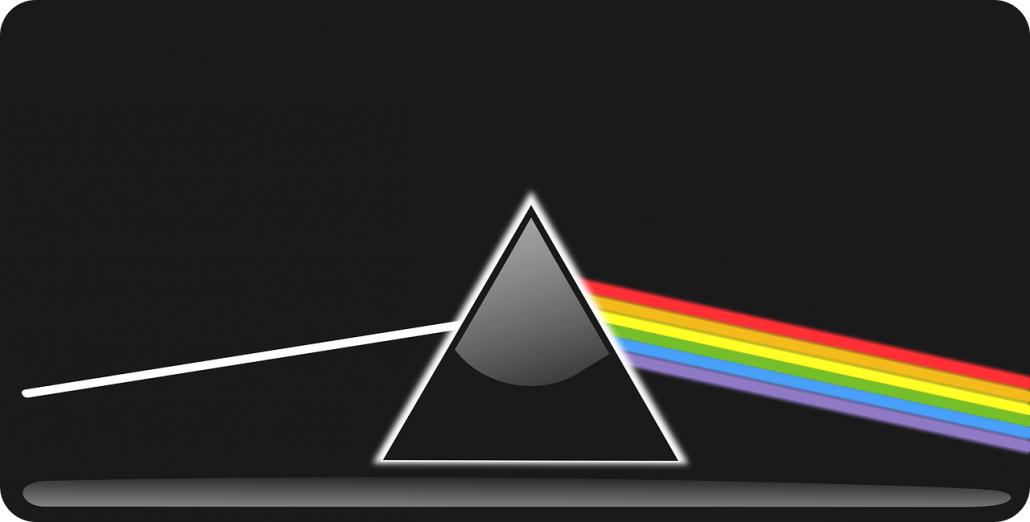
A definition of “Light” is: “[…] electromagnetic radiation that specifically falls within a certain part of the electromagnetic spectrum. The word “light” usually refers to visible light, meaning light that is visible to your eye and is responsible for your sense of sight. (International Lighting Vocabulary, 1987).
Furthermore light is: “[…] specifically defined as light that has a wavelength in the range of 400-700 nanometres (nm), which falls just between infrared light (which is light with longer wavelengths) and ultraviolet light (which is light with shorter wavelengths).” (Pravati, 2001; Buser et al., 1992).
This little excurse was necessary to get at least a glimpse on why/how the Re-Timer® is supposed to work.
Using this biohacking device means using special designed glasses (see picture) who direct blue-green light of specific wavelength within the spectrum of light, 500nm of illuminance 506 lux, to be precisely (Scott et al., 2018).
The RE-TIMER® [affiliate link] Glasses:
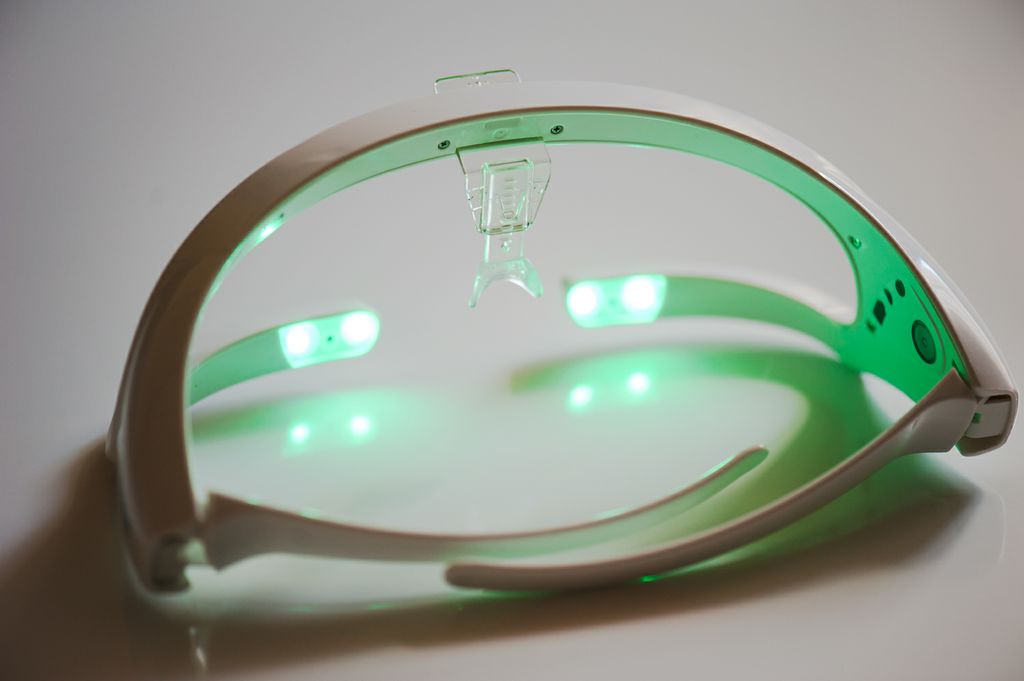
This light is directed to the eye: “ […] “through 4 light emitting diodes positioned on the lower portion of the plastic frame ~20 mm from the eye. These light therapy glasses are recommended by the manufacturer for the treatment of sleep disturbances, jet lag and seasonal affective disorder, and have been shown to significantly alter circadian rhythms in healthy young adults” (Scott et al., 2018).
By the way, when I talk about a so called “biohacking” device I refer to the term as of the definition in the Merriam Webster Dictionary:
“biological experimentation (as by gene editing or the use of drugs or implants) done to improve the qualities or capabilities of living organisms especially by individuals and groups working outside a traditional medical or scientific research environment”
To be precise here’s a detailed overview of the used light technology and light spectrum intensity of the Re-Timer®:
| Lighting technology | 4 Light-emitting diodes (LEDs), 0.1 watts, diffuser cover technology |
| Light spectrum intensity | Green-blue 500 nm dominant wavelength, UV-free light High setting is 506 Lux lm/m² and 230 µW/cm² Low setting is 315 Lux lm/m² and 143 µW/cm² We have chosen an intensity range that balances high efficacy with safety. Eyes are precious organs, and excessively higher intensities that may compromise this balance should be avoided. |
| Light pulse | 50 to 166 hertz. Not suitable for those who suffer epilepsy or similar conditions. |
Figure 6: Light technology and Light spectrum intesity of a RE-TIMER® device; source: © RE-TIMER®.
Are you what you eat or how your clocks tick?
So might it be the case, that we aren’t only what we eat respectively our microbiome absorbs but also how well our intracellular “clocks” tick?
Digging deeper into the function of the CR we now should take a look at its “central pacemaker” and how the hormone Melatonin is involved into it.
Besides every cell having its very own “clock”, they all seem to be synchronized to this “central pacemaker”, which is supposed to be located in our suprachiasmatic nucleus (SCN) of the hypothalamus (Golombeck and Rosenstein, 2010).
Again, we here first have to decode the word supra/chiasmatic and hypo/thalamus to get things a bit easier to understand.
The term supra/chiasmatic derives from the Latin prefix supra- = above, and from Greek chiasma, chiasmatos = Crossing/Crossing of nervers or visual fibers (Becher et al., 1995). Nucleus is the Latin word for core (Becher et al., 1995).
Take a look at my pictures of the brain (cut in sagittal plain) below, to get a better imagination of where the SCN (blue dot) is approximately located in the human brain.
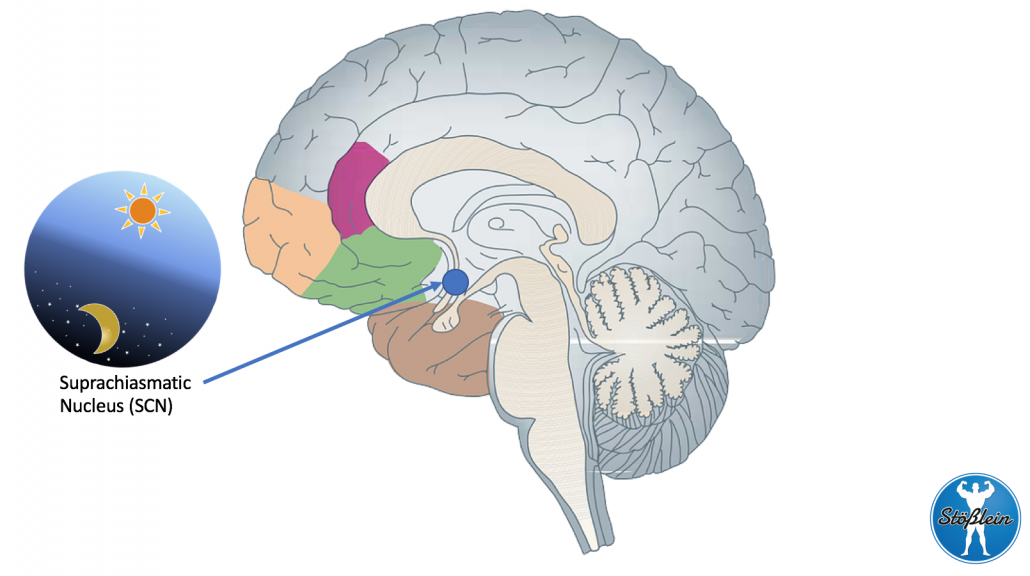
So, the SCN is one of many cores, located within the Hypothalamus (red shape). The following image shows an approximately location of the Hypothalamus.
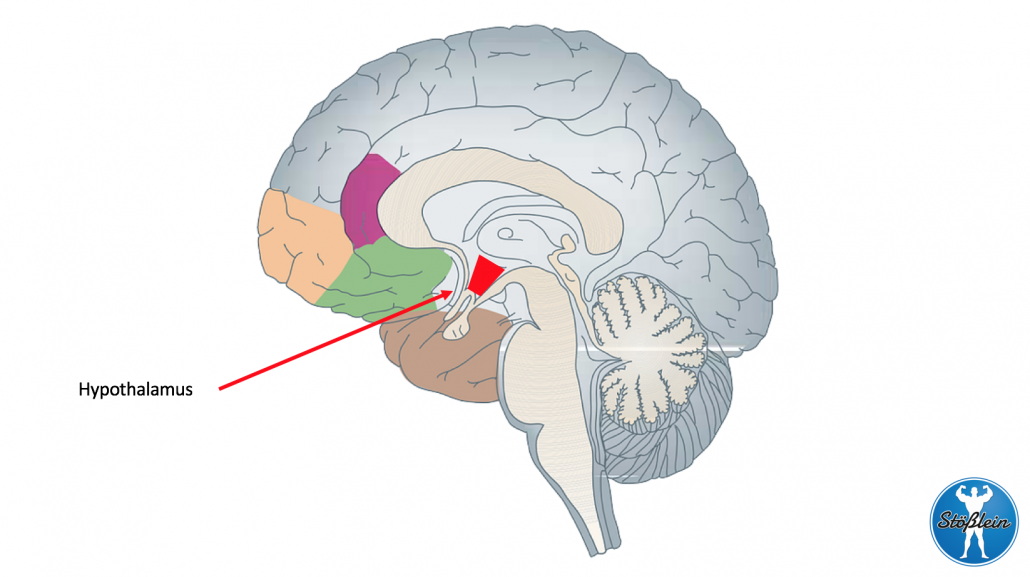
With this little and very brief overview it might be easier to understand that the SCN secretes the so called “chief circadian hormone” (Melatonin) through sympathic projections to the pineal gland (McKena, 2017).
Furthermore, it is supposed to be that:
“During a typical light/dark cycle, pineal melatonin secretion begins between 9 and 11 pm, reaches a peak between 1 and 3 am and falls to baseline again between 7 and 9 am.” (Pevet and Challet, 2011; Brzezinski, 1997).
From the point of Glombek and Rosenstein “Melatonin acts at cell surface receptors within the central nervous system, where it regulates the sleep/wake cycle. It also acts on peripheral tissues, stabilising their circadian rhythms and aligning the phase relationships of different peripheral clocks.”
So get things a little more practical, you can simply say that you might use light (in a specific range) to adjust or “re-time” your circadian rhythm.
Let’s say you don’t go to bed between 9 and 11pm and do not wake up between 7 and 9 am, this might interrupt your CR respectively your sleep-wake-rhythm.
For example if you’re a shift worker, travel through different time zones (Jet-Lag) or it just happens according to seasonality (in winter, when you do not have that much hours of light like in summer).
On the manufacturer’s website you can i.e. use a RE-Timer Jet-Lag Calculator https://www.re-timer.com/the-product/jet-lag-calculator/ which might help you dealing with Jet-Lag.
With all these issues using the light of a Re-Timer® might help. I give you my personal experience with it.
How I experienced the Re-Timer®
When it comes to the different birds, I’m definitely an owl. I like to stay up late and sleep long in the morning. I sometimes stay up until 3:30am, sleep up to 11 o’clock. Having used the Re-Timer® just for one week (6days on, 1 day off) seems to really have “re-timed” my CR.
I now get tired around midnight and wake up aroung 8/9 am. What really surprised me was how fast this effect occurred! Another positive thing to mention is definitely no more tiredness in the afternoon around 15/16 pm.
At the moment of writing this (August 2019) I cannot yet give personal experience how this might work in winter. But I’ll post my updates here, letting you know.
The Re-Timer® [affiliate link] comes in a decent box that protects your glasses while travelling. You can switch between two modes, which are indicated by two LEDs on the right earpiece.
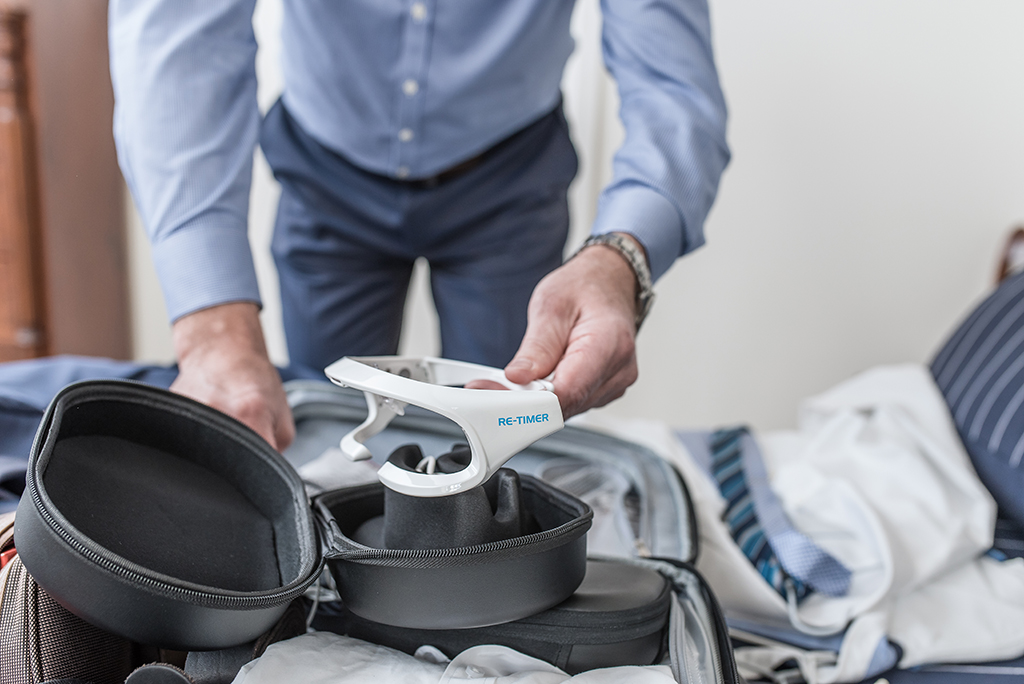
Also located on the right side is the Re-Timer’s battery LEDs. If you wear the Re-Timer® it’s timed to 60 minutes and will automatically switch off after an hour.
If I wear it and look out of the window (especially to white surfaces or a grey sky) I see everything with a light red touch. This stops immediately after taking the device off.
Human Charger ® – Sun in your ears?
Another of my Photobiomodulation-Tools I’ve been using for quite a while now is the so called “Valkee” made by a company from Finland, named “Human Charger®” [advertisement, not payed]. It looks like a little MP3-Player which basically “lights up your ears” through earbuds (see photo).
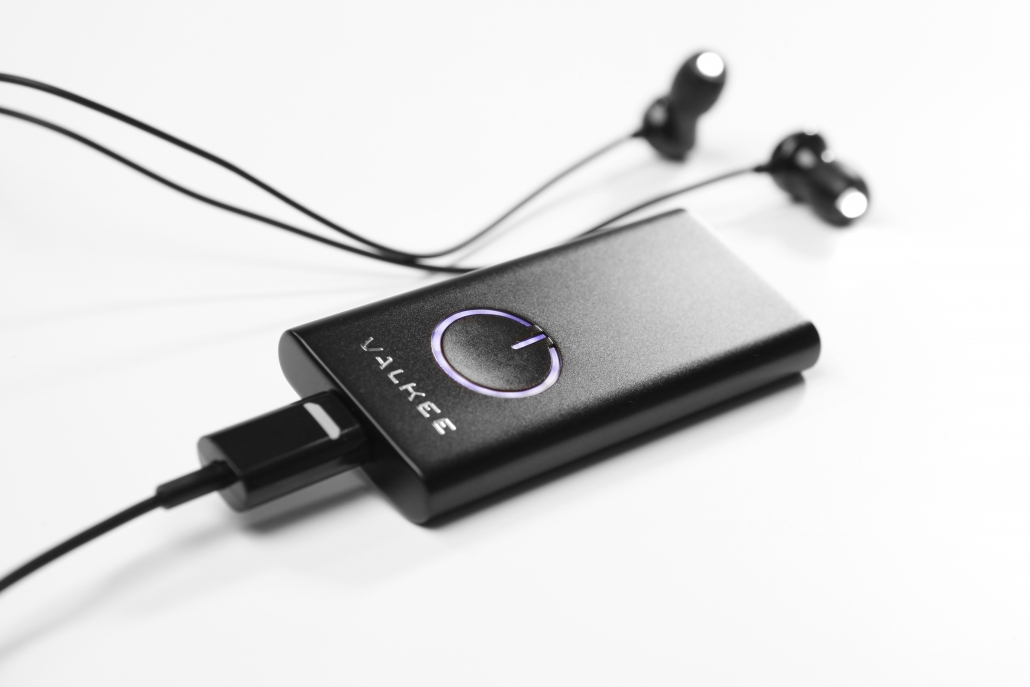
The science behind it is quite simple:
The human brain seems to be inherently sensitive to light and the human brain is supposed to react to transcranial extraocular light.
In his study/Doctoral Dissertation: “Effects of transcranial light on molecules regulating circadian rhythm” Antii Flykman writes that:
“Light acts as the most important regulating and entraining factor of the mammalian circadian rhythm. This rhythm has evolved to set phases, in which different physiological and behavioral events occur at the right time of the day to synchronize the organism. The mechanism of light transduction via eyes to the brain and its effects on circadian rhythmicity is well known […]” (Flykman, 2018).
In another scientific study/Dissertation researchers found out that:
“[…] The light signal is traditionally assumed to only be mediated via the eyes. Recent studies have suggested the existence of putatively light sensitive structures in the rodent and human brain and penetration of light into the skull and brain tissue has been observed. The brain activation observed during transcranial bright light (TBL) exposure indicates a direct light responsivity of brain tissue […]” (Jurvelin, 2018).
To keep thing easy this just means, that humans seem to also have light receptors in their ears and that this light might reach their brains (through the scull bone) also “through the ear” instead of only through our retina.
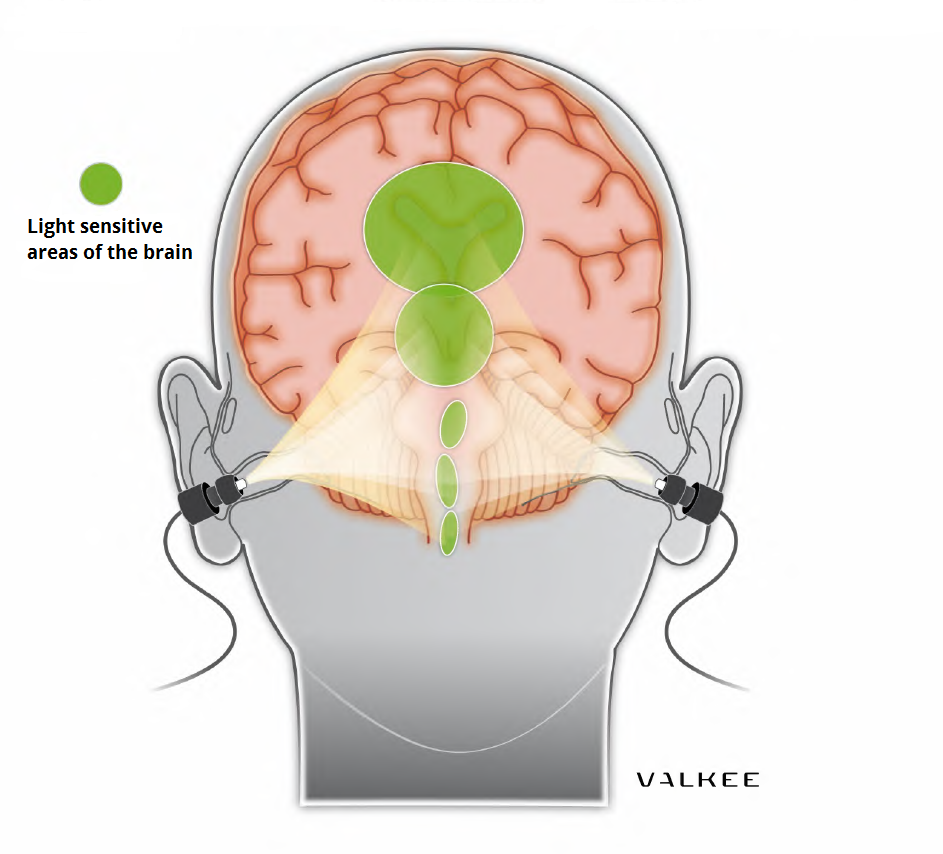
Retina by the way derives from Latin rete = net (Becher et al., 2019). In German there’s a more accurate translation to retina “Netzhaut”. Literally translated that would be “net skin”.
The picture below gives you a little overview about the anatomy of a human eye, just in case you feel a little “lost in translation” 😉
“The retina is the innermost, light-sensitive layer of tissue of the eye of most vertebrates and some molluscs. The optics of the eye create a focused two-dimensional image of the visual world on the retina, which translates that image into electrical neural impulses to the brain to create visual perception, the retina serving a function analogous to that of the film or image sensor in a camera.” (Wikipedia, 2019).
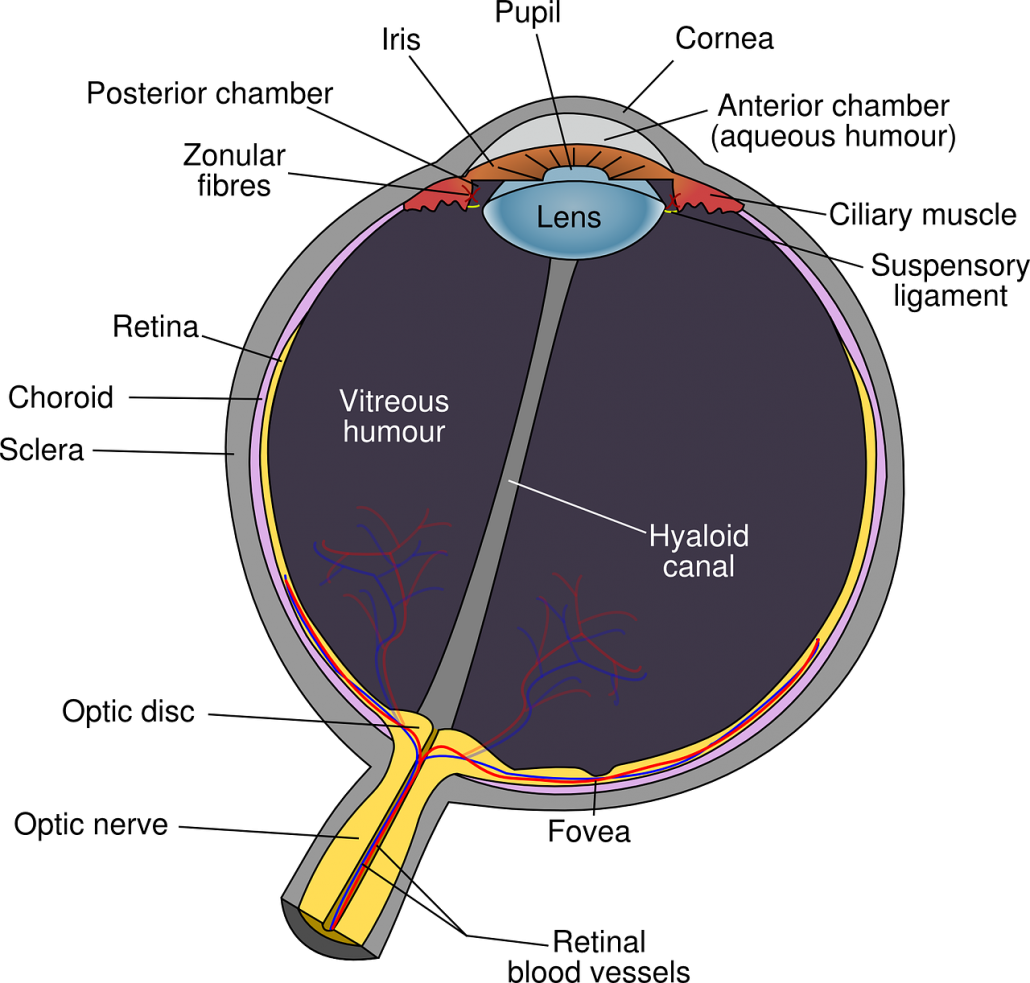
A study from 2017 indicated though, that a special photopigment (melanopsin (OPN4)) i.e. – which is especially reactive to blue light – is also located within the human brain and not exclusively in humans’ retinas (Nissilä et al., 2017).
In a research article named “Human Brain Reacts to Transcranial Extraocular Light”, Sun et al. documented their investigation whether the human brain is sensitive to extraocular light (Sun et al., 2016).
Extraocular again is a medical term that can easily be split into extra/auricular and be “decoded” into: the Latin prefix extra = outlying, outside and Latin oculus = eye (Becher et al., 1995). So extraocular means = “lying outside of the eye”.
Transcranial can be “decoded” into trans/cranial which is the composite of the Latin prefix trans- = over/across/beyond and Latin -respectively – Greek kranion = skull (Becher et al., 1995).
They (Sun et al.) draw the conclusion that:
“Extraocular light delivered through the ear canals was shown to penetrate at the base of the scull of a cadaver. Thus, we have shown that extraocular light impacts human brain functioning calling for further research on the mechanisms of action of light on the human brain.” (Sun et al., 2016).
Although this study was performed on a scull of a cadaver (*see Literature for explanation) it this showed that light – applied through the ear canal – seems to have reached the cadaver’s brain!
Furthermore, there was also ongoing investigation on healthy, living subjects (18 young males).
„Extraocular light was delivered using a commercial Bright Light Ear Headset (NPT1100, Valkee Oy, Oulu, Finland; […]). UV-free and blue-enriched LED light with maximum of 3.5 Lumens was presented via both ear canals. The light has a photon density of 1.13 × photons · · with a peak in the blue region around 448 nm” (Sun et al., 2016).
The bold accentuation was added by me!

According to the application of extraauricular light you might also find the following studies interesting:
- Transcranial bright light and symptoms of jet lag: a randomized, placebo-controlled trial (Jurvelin et al. 2015)
- Transcranial light affects plasma monoamine levels and expression of brain encephalopsin in the mouse (Flyktman et al. 2015)
- Effects of bright light treatment on psychomotor speed in athletes (Tulppo et al. 2014)
- Transcranial bright light exposure via ear canals does not suppress nocturnal melatonin in healthy adults –a single-blind, sham-controlled, crossover trial (Jurvelin et al. 2014)
- Altered resting-state activity in seasonal affective disorder (Abou-Elseoud et al. 2014)
- Transcranial bright light treatment via ear canals in seasonal affective disorder: a randomized controlled double-blind dose-response study (Jurvelin et al. 2014)
- Stimulating brain tissue with bright light alters functional connectivity in brain at the resting state (Starck et al. 2012)
- Can transcranial brain-targeted bright light treatment via ear canals be effective in relieving symptoms in seasonal affective disorder? A pilot study (Timonen et al. 2012)
I find it quite amazing how many studies and investigational research is actually going on these days of how specific wavelength of light or light in general may affect the human body.
If you take a little time for yourself and dig a little into latest research (see list above) you’d be probably amazed, too.
Therefore I consider the topic of photobiomodulation much more as merely some “biohacking-stuff” but much more of common sense and “state of the art” information/knowledge.
If you want to know how light in general might affect our bodies read my article: “Biophotons: are all nutrition advices are merely belief systems?”
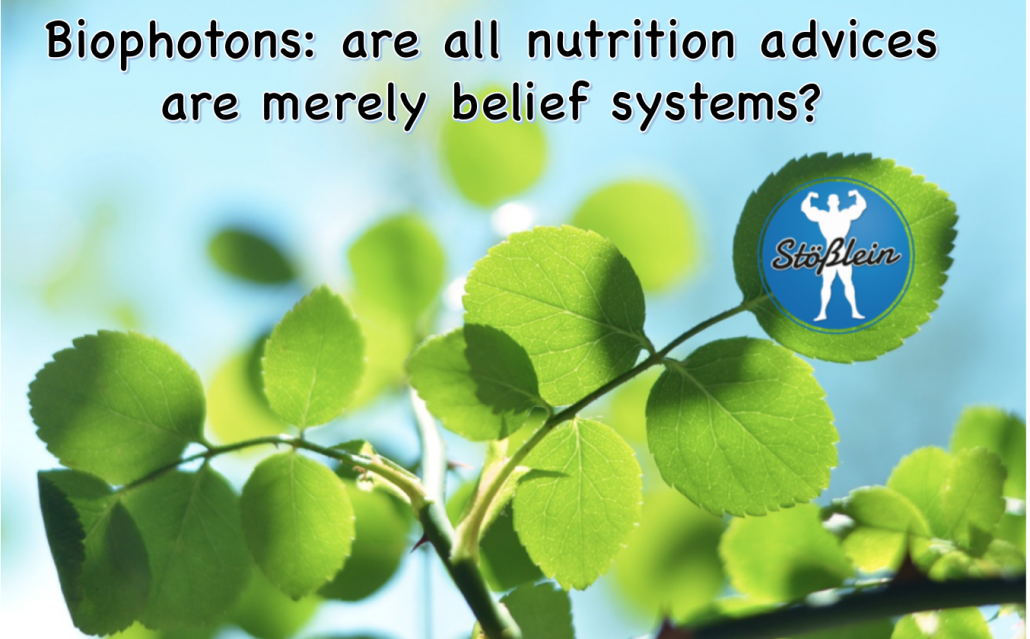
My own experience with the “Valkee”
From my point of view the “Valkee” is a very convenient tool for Photobiomodulation. As I’m writing on this article (August 2019) it’s summer and I’d like to wait how I might experience a difference in the Valkee’s effect on my body during winter. I’ll keep you informed and will update this article.
Up to now I can say that the valkee is very easy to use, it’s a “plug and play”. There is only one button you can press, that starts the “treatment” and the LEDs on the circle indicate the remaining time, automatically switching off when 12 minutes are over.
My ears haven’t got “hot” nor have I experienced any uncomfortable heat in my ears while using the “Valkee”.
I use it pretty much every day (6 out of 7).
Conclusion
As you might see, a single article is by far way too short to cover all the myriads of interesting effects all kind of lights might have to the human body.
That’s why I focused in this article on only two Photobiomodulation tools I’ve been using recently to share my personal experience because – in my opinion – “sharing is caring”.
When it comes to the Circardian Rhythm I’ll always be rather an owl than a lark. So I was quite amazed when I started using the Re-Timer® [affilaite link] as well as the “Valkee” by “Humancharger®”.

Having stayed up (voluntary) until about 3:30 every night I first didn’t believe those “tools” would have any noticeable effect, or if they might have, it would take probably weeks to notice.
Get me right, I haven’t had any sleep disorders but I just enjoyed staying up while everybody is still asleep. Just to embrace the silence and solitude (don’t mix this up with loneliness, big difference!).
So, being some kind of “human guinea pig” I tried both devices in combination. I wake up, get my 12 minutes of “sunshine in my ears” and put on my “Re-Timer-Galsses” for a treatment of 60 minutes.
Having used it for 6 consecutive days my CR went back to “normal”. I now get tired around 11/12 pm, go to bed and wake up pretty much accurate around 8/9 am!
I don’t have this little tiredness in the afternoon which would “hit” me around 15/16 o’clock anymore.
So, for me, those tools seem to work which is why I’ll keep them in my “biohacking tool box”.
Last but not least I’d like to mention that I’ve been using so called blue light blocking apps/software on my smartphone as well as on my laptop. So if you like/have to stay up late and do your research, work, whatsoever, you might draw this in consideration.
These apps/software is commonly for free and you might find it probably for any provider.
© HP Bernd Stößlein, Master of Business Administration in Sportmanagement.
If you liked this article please share it with your friends, subscribe to my blog and newsletter or feel to contact me: info@bernd-stoesslein.de
Literature
Lateinisch-griechischer Wortschatz in der Medizin, 1995, S. 47.
Lateinisch-griechischer Wortschatz in der Medizin, 1995, S. 57.
Lateinisch-griechischer Wortschatz in der Medizin, 1995, S. 58.
Lateinisch-griechischer Wortschatz in der Medizin, 1995, S. 78.
Lateinisch-griechischer Wortschatz in der Medizin, 1995, S. 57.
Lateinisch-griechischer Wortschatz in der Medizin, 1995, S. 126.
Lateinisch-griechischer Wortschatz in der Medizin, 1995, S. 148.
Lateinisch-griechischer Wortschatz in der Medizin, 1995, S. 188.
Lateinisch-griechischer Wortschatz in der Medizin, 1995, S. 47.
Lateinisch-griechischer Wortschatz in der Medizin, 1995, S. 217.
Lateinisch-griechischer Wortschatz in der Medizin, 1995, S. 231.
Lateinisch-griechischer Wortschatz in der Medizin, 1995, S. 235.
Merriam Webster: Chronotype, Source: https://www.merriam-webster.com/medical/chronotype, acces: 7.8.19.
Liia Kivelä; Marinos Rodolfos Papadopoulos; Niki Antypa. Chronotype and Psychiatric Disorders. Current Sleep Medicine Reports 2018, 4 (2), 94–103 DOI: 10.1007/s40675-018-0113-8.
Montaruli, A.; Galasso, L.; Caumo, A.; Cè E; Pesenti, C.; Roveda, E.; Esposito, F. The Circadian Typology: The Role of Physical Activity and Melatonin. Sport Sciences for Health : Founded by the Faculty of Exercise Science – University of Milan, Official Journal of the Italian Society of Exercise and Sport Sciences 2017, 13 (3), 469–476 DOI: 10.1007/s11332-017-0389-y.
Horne JA, Östberg O. A self-assessment questionnaire to determine morningness-eveningness in human circadian rhythms. Int J Chronobiol. 1976;4:97–110.
Roenneberg, T.; Wirz-Justice, A.; Merrow, M. Life between Clocks: Daily Temporal Patterns of Human Chronotypes. Journal of Biological Rhythms 2003, 18 (1), 80–90 DOI: 10.1177/0748730402239679.
Fabbian, F.; Zucchi, B.; De Giorgi, A.; Tiseo, R.; Boari, B.; Salmi, R.; Cappadona, R.; Gianesini, G.; Bassi, E.; Signani, F.; et al. Chronotype, Gender and General Health. Chronobiology International 2016, 33 (7), 863–882 DOI: 10.1080/07420528.2016.1176927.
Au J; Reece J. The Relationship between Chronotype and Depressive Symptoms: A Meta-Analysis. Journal of Affective Disorders 2017, 218, 93–104 DOI: 10.1016/j.jad.2017.04.021.
Melo, M. C. A.; Abreu, R. L. C.; Linhares Neto, V. B.; de Bruin, P. F. C.; de Bruin, V. M. S. Chronotype and Circadian Rhythm in Bipolar Disorder: A Systematic Review. Sleep Medicine Reviews 2017, 34, 46–58 DOI: 10.1016/j.smrv.2016.06.007.
Chan, M.-C.; Spieth, P. M.; Quinn, K.; Parotto, M.; Zhang, H.; Slutsky, A. S. Circadian Rhythms: From Basic Mechanisms to the Intensive Care Unit*. Critical Care Medicine 2012, 40 (1), 246–253 DOI: 10.1097/CCM.0b013e31822f0abe.
McKenna HT; Reiss IK; Martin DS. The Significance of Circadian Rhythms and Dysrhythmias in Critical Illness. Journal of the Intensive Care Society 2017, 18 (2), 121–129 DOI: 10.1177/1751143717692603.
Kusanagi, H.; Hida, A.; Satoh, K.; Echizenya, M.; Shimizu, T.; Pendergast, J. S.; Yamazaki, S.; Mishima, K. Expression Profiles of 10 Circadian Clock Genes in Human Peripheral Blood Mononuclear Cells. Neuroscience Research 2008, 61(2), 136–142 DOI: 10.1016/j.neures.2008.01.012.
Bozek K; Relógio A; Kielbasa SM; Heine M; Dame C; Kramer A; Herzel H. Regulation of Clock-Controlled Genes in Mammals. Plos One 2009, 4 (3), 4882 DOI: 10.1371/journal.pone.0004882.
Lim AS; Chang AM; Shulman JM; Raj T; Chibnik LB; Cain SW; Rothamel K; Benoist C; Myers AJ; Czeisler CA; et al. A Common Polymorphism near Per1 and the Timing of Human Behavioral Rhythms. Annals of Neurology 2012, 72 (3), 324–334 DOI: 10.1002/ana.23636.
Facer-Childs E; Brandstaetter R. The Impact of Circadian Phenotype and Time Since Awakening on Diurnal Performance in Athletes. Current Biology : Cb 2015, 25 (4), 518–522 DOI: 10.1016/j.cub.2014.12.036.
International Lighting Vocabulary. Number 17.4. CIE, 4th edition. By the International Lighting Vocabulary, the definition of light is: “Any radiation capable of causing a visual sensation directly.”
Read S.A; Pieterse E.C; Alonso-Caneiro D; Bormann R; Hong S; Lo C.-H; Richer R; Syed A; Tran L. Daily Morning Light Therapy Is Associated with an Increase in Choroidal Thickness in Healthy Young Adults. Scientific Reports 2018, 8 (1) DOI: 10.1038/s41598-018-26635-7.
Golombek, D. A.; Rosenstein, R. E. Physiology of Circadian Entrainment. Physiological Reviews 2010, 90 (3), 1063–1063.
Pevet, P.; Challet, E. Melatonin: Both Master Clock Output and Internal Time-Giver in the Circadian Clocks Network. Journal of Physiology – Paris 2011, 105 (4), 170–182 DOI: 10.1016/j.jphysparis.2011.07.001.
Brzezinski A. Melatonin in Humans. The New England Journal of Medicine 1997, 336 (3), 186–195.
Effects of transcranial light on molecules regulating circadian rhythm
by S. (Seppo) Saarela, S. (Satu) Mänttäri, M. (Markku) Timonen, A. (Antti) Flyktman 2018.
Retina, Source: https://en.wikipedia.org/wiki/Retina, access 11.8.19.
Sun, L.; Peräkylä Jari; Kovalainen, A.; Ogawa, K. H.; Karhunen, P. J.; Hartikainen, K. M.; Hamblin, M. Human Brain Reacts to Transcranial Extraocular Light. Plos One 2016, 11 (2) DOI: 10.1371/journal.pone.0149525.
* ”(The study protocol was approved by the Regional Ethical Committee of Tampere University Hospital with permission number R09097. In Finland when a study has ethical committee approval and an autopsy is routinely done as is Extraocular Photosensitivity of Human Brain PLOS ONE | DOI:10.1371/journal.pone.0149525 February 24, 2016 4 / 12 the case with sudden death, no next of kin consent and no previous permission from the diseased subject or their relatives is required, […]” (Sun et al., 2016).



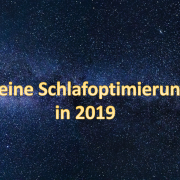
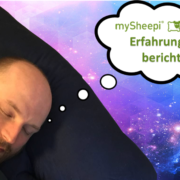


Trackbacks & Pingbacks
[…] Wie bereits geschrieben, findet man dazu meinen ausführlichen Erfahrungsbericht, in meiner Artikel: „Photobiomodulation | Meine Chronotypen“. Diesen Artikel gibt’s übrigens auch auf Englisch, hier. […]
[…] This article is also available in English […]
Dein Kommentar
An Diskussion beteiligen?Hinterlasse uns Deinen Kommentar!